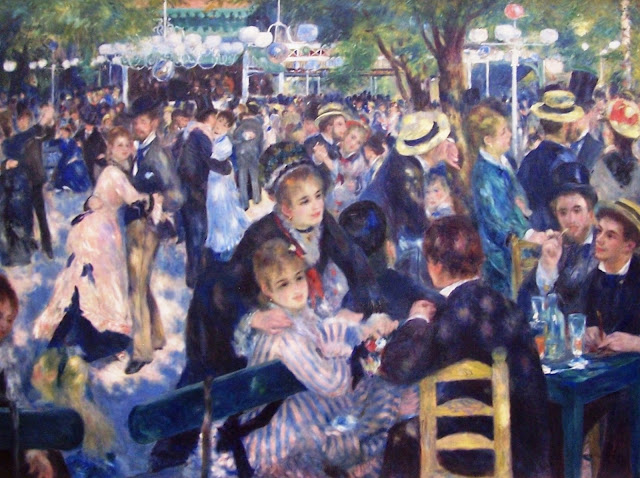I was watching the new Rick Steves episode on Paris, and I realized I had never done a blog post on my visit to the Musée d'Orsay. WOW! Me, a lover of Impressionist art, and I completely forgot about this museum.
The Musée d'Orsay was installed in the old Orsay railroad station and hotel which had been built for the 1900 World's Fair. After 1939, the station's platforms had become too short for the longer trains that had come into service. The station then was used as a mailing center during World War II and several times as a movie set. The hotel closed in 1973, and the building was threatened with demolition. In 1975, the idea came about to install a new museum in the train station, and in 1977, the decision was made to create the Musée d'Orsay. The building was deemed a national monument in 1978 and the museum was officially opened on December 9, 1986.
I recently read on the museum's website that they have changed their policy regarding photography:
In
the interests of the safety of works and visitors, and to ensure a more
pleasurable visit, photography and filming are no longer allowed in the
museum galleries. This measure has been introduced in view of the
increased number of visitors taking photographs “at arm’s length” using
mobile phones.
Luckily, my visit to Paris was in 2006 was when photography was still permitted.
Photos: www.musee-orsay.fr


The photos above (courtesy of the Museé d'Orsay website) show Gare d'Orsay. Does it seem possible from my photo below that railroad tracks once ran through these galleries?
The beautiful ornate station clock still hangs in the same approximate place.
The idea of the Musée d'Orsay was to house works of art from the second half of the 19th century to 1914, basically bridging the gap between the Louvre and the modern art museum at the Pompidou Center.
Of course the Impressionists are a highlight. Let's start with some painted before the term Impressionism was even coined.
You might automatically think Claude Monet when you first see this painting, but it was actually painted by a French artist named Armand Guillaumin.
Chemin Creux, Effet de Neige (1869) by Armand Guillaumin
There are currently 88 works by Monet in the museum. Here are some earlier works:
Régates à Argenteuil (1872) by Claude Monet
Le Déjeuner : Panneau Décoratif (1873) by Claude Monet
Le Dindons (1877) by Claude Monet
La Rue Montorgueil, à Paris. Fête du 30 juin 1878 (1878) by Claude Monet
Auguste Renoir was known more for his portraits, many of fleshly women, but look at this gorgeous landscape by him!
Chemin Montant dans les Hautes Herbes (1877) by Pierre Auguste Renoir
Of course, one of Renoir's early works is also one of his most beloved and Impressionism's most celebrated paintings. The painting was part of the personal collection donated to the French government by French painter Gustave Caillebotte upon his death. Caillebotte was friends with the Impressionist painters, often purchasing their works to help them financially (he came from a wealthy family), but he himself did not paint in the Impressionist manner.
Bal du Moulin de la Galette (1876) by Auguste Renoir
Édouard Manet is considered a pivotal figure in the transition from Realism to Impressionism. This controversial painting by him was rejected by the jury of the Académie des Beaux-Art's annual Salon de Paris art exhibition in 1863 because of the realist nude portrayed. Thus, he exhibited the painting later in the year in the Salon des Refusés (Salon of the Rejected).
Le déjeuner sur l'Herbe (1863) by Édouard Manet
Two years later Manet continued to shock audiences when he exhibited this painting at the Salon de Paris. This time it wasn't the nudity that shocked people, it was how Manet portrayed the model as an obvious courtesan, right down to the title: the name was associated with prostitutes in Paris during this time.
Olympia (1863) by Édouard Manet 
Much less controversial is this beautiful portrait of his sister-in-law, Berthe Morisot. Though she married Eugène Manet, it is widely suggested that Berthe Morisot had a romantic relationship with Édouard Manet prior to her marriage to Eugène.
These are a few of the masterpieces hanging in the Musée d'Orsay. In my next post, I'll show you more of the beautiful permanent collection in this world-class museum including beautiful works by van Gogh and later works by Monet.
For more information visit: http://www.musee-orsay.fr.
To get to the Musée d'Orsay, use:
Metro: Line 12 to Solférino
RER: Line C to Musée d'Orsay
Bus: Lines 24, 63, 68, 69, 73, 83, 84, 94
- Regular admission is €9.00.
- FREE with your Paris Museum Pass.
- There may be a charge for special exhibitions.
- Closed Mondays.
- Closed January 1, May 1, Christmas Day.
- Open 9:30-6:00 on Tuesday-Thursday.
- Open 9:30-9:45 on Thursday
NOTE: All photos of the paintings in this blog post were taken by me on my visit to the Musée d'Orsay in May, 2006.






















